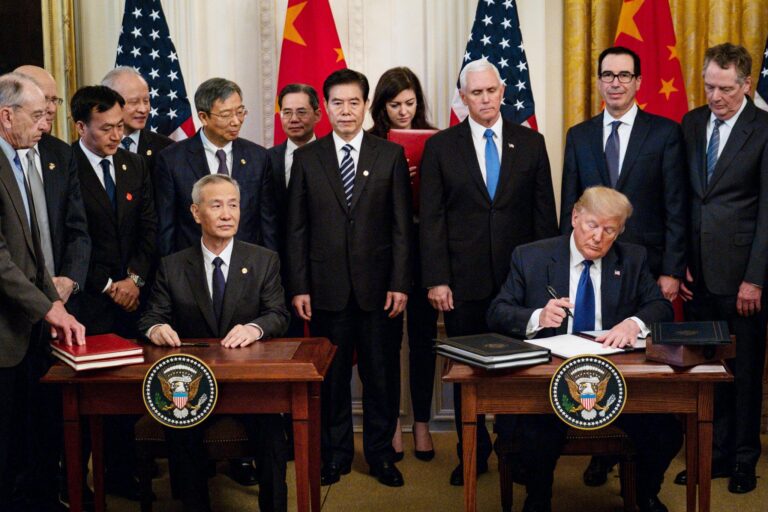The China Trade Agreement: A New Era for Global commerce
In the dynamic realm of global trade, few agreements have sparked as much debate and analysis as the recent trade pact with China. As tensions between major economies continue to simmer, this significant agreement seeks to transform trade relations and tackle long-standing economic issues. To truly understand its effectiveness and ramifications, we can look at industry leaders like walmart—one of the most powerful entities in international commerce—as essential indicators. This article delves into the ramifications of the China trade deal through walmart’s operational lens,investigating how this agreement could alter retail strategies,supply chain logistics,and consumer pricing amid a rapidly evolving economic landscape. with insights from key market players and analysts, we aim to address a pivotal question: How beneficial is the china trade deal in reality?
assessing Long-Term Effects of the China Trade Agreement on Retail Giants
The long-term consequences of the China trade agreement have elicited varied responses from retailers such as Walmart that depend heavily on global supply chains. For these retail behemoths,this deal presents both opportunities for growth and challenges that could redefine their operations. Several critical factors warrant consideration:
- Cost Savings: Lower tariffs may result in reduced import expenses for products typically sourced from China, positively influencing profit margins.
- Market Penetration: The agreement might enhance Walmart’s capacity to enter Chinese markets more effectively by accessing a vast consumer demographic.
- Supply Chain Robustness: Diversifying sourcing options in response to tariff fluctuations could help mitigate future risks; however, adaptation may require time and financial investment.
Still, potential advantages must be balanced against possible drawbacks. Retailers are continually challenged with maintaining quality while implementing cost-reduction strategies. Furthermore, public perception regarding products manufactured in China remains an issue that could affect sales figures considerably. To illustrate these potential impacts further, consider this table summarizing projected outcomes based on retailer reactions:
| Outcome | Positive Impact | Negative Impact |
|---|---|---|
| Profit Margins | ↑ Decreased tariffs | ↓ Rising operational costs |
| Market Growth Potential | ↑ Access to Chinese consumers | ↓ Brand perception challenges |
Walmart’s Strategic Responses to evolving Trade Policies
The changing landscape of international trade regulations has necessitated significant adjustments in Walmart’s operational strategies. As tariffs fluctuate alongside new agreements, this retail giant has concentrated on diversifying its supply chain to minimize disruptions caused by external factors. By investing in local sourcing initiatives and building relationships with domestic suppliers, Walmart aims to maintain stable inventory levels that meet consumer demand while avoiding unpredictable tariff impacts.Main strategies include:
- Cultivating Supplier Partnerships:Create stronger ties with current suppliers while onboarding new local vendors to reduce reliance on overseas sources.
- Pioneering Technological Investments:Add advanced supply chain management systems designed for improved visibility and efficiency across operations.
- Dynamically Adjusting Pricing Strategies:Tweaking pricing models based on shifts in tariff costs while ensuring competitiveness remains intact.
this environment also sees Walmart prioritizing sustainability alongside ethical sourcing practices—aligning business operations with modern consumer expectations. The company acknowledges that transparency within its supply chain not only fosters brand loyalty but also shields it against adverse effects stemming from changes in trade policies. This dual focus positions Walmart advantageously amidst ongoing global tensions—leading towards a more resilient business framework.The company’s commitments encompass:
- Sustainability Initiatives:Aiming for reduced carbon emissions through eco-kind product offerings and lasting shipping methods.
- Your Community Matters Initiative: Investing back into local communities via job creation efforts and support for regional economies.
- Compliance & ethical Standards: Adhering strictly to compliance protocols ensuring ethical treatment throughout its entire supply network .
Adaptation Strategy Description
Local Sourcing Collaborating with domestic suppliers to lessen dependence on foreign imports . Supply Chain Technology Employing cutting-edge software solutions enabling real-time tracking & inventory oversight . Price Management Adjusting prices responsively according market conditions & cost fluctuations . Consumer Insights : How The Trade Deal Influences Pricing And Product Accessibility < p As consumers navigate through intricate aspects surrounding various trading arrangements , implications arising out recent china -trade pact become increasingly evident at major retailers like walmart. This arrangement aims primarily towards lowering tariffs applicable across numerous goods , potentially resulting lower prices everyday items shoppers frequently purchase . Many customers report noticing alterations price tags associated diverse categories products available stores today ; key sectors where consumers might experience noticeable effects include :
- < strong Electronics : Expect modest reductions prices smartphones laptops etc ;
- < strong Textiles Apparel : Anticipate decreased costs clothing brands accessories alike ;
- < strong Household Goods : Expect lower rates kitchenware furniture cleaning supplies etc ;
<p However , it’s crucial recognise pricing isn’t sole factor impacted here — product availability constitutes another vital element influenced by aforementioned trading arrangement too ! Shifts occurring within tariff structures prompted businesses reassess their respective supply chains which may lead enhanced inventory levels certain goods found retail outlets nationwide ! While some shoppers enjoy improved access wider assortment products others face temporary shortages specific categories altogether ! Below provides speedy overview illustrating how these dynamics shape consumer choices moving forward :</ p
/ tr /
/thead /
<tbody /
/tr /
<tr //tr / /tbody /
/table />
<h2 id = "conclusion" In conclusion/h2
The recent china -trade pact serves multifaceted barometer broader u.s economy whose implications extend far beyond mere negotiations surrounding tariffs alone! As evidenced through walmarts adaptive measures taken thus far effectiveness derived from said agreement varies significantly depending upon sector involved stakeholders engaged therein! While intended stabilize enhance overall trading relations actual benefits remain under scrutiny backdrop shifting global economic landscapes evolving patterns observed among consumers alike! Moving ahead all parties involved corporations individuals alike must closely monitor ongoing repercussions stemming forth discussions recognizing success ultimately hinges adaptability responsiveness changing dynamics present day international commerce arena! Ultimately true measure any given trading accord lies ability foster sustainable growth equitable access markets objectives necessitating continuous collaboration negotiation increasingly interconnected world!




